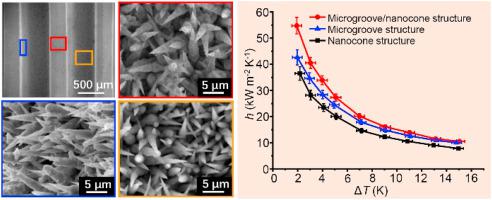Materials Today Physics ( IF 10.0 ) Pub Date : 2021-04-20 , DOI: 10.1016/j.mtphys.2021.100407 Shihan Chen , Rui Wang , Feifei Wu , Hailang Zhang , Xuefeng Gao , Lei Jiang

|
Currently, developing high-efficiency condensation heat transfer (CHT) interfaces via known or unknown copper micro/nanofabrication technologies with practical prospects attracts great interest due to its values in developing next generation small-space high-heat-flux dissipation technologies. Here, we report that CHT performance of copper surface can be enhanced via skillful combination of microgroove skeleton and superhydrophobic nanocone covering, which can be fabricated by wire electrical discharge machining, electroless copper plating and thiol modification technologies. We first explore the influence of groove width, groove depth and fin width to condensation heat and mass transfer and obtain the optimized microgroove structure. Subsequently, such structure is demonstrated to have more superior CHT performance than the micropillar with comparable geometric parameters. Further, we verify that the superhydrophobic hierarchical structure has the best performance, which shows maximally 82.9% enhancement in CHT coefficient as compared to the flat hydrophobic copper, while the optimized microgroove structure performs better than the nanocone. Their structure-property relationships are rationalized according to the fundamentals of condensation mass and heat transfer. Clearly, this work not only helps understand how micro- and nanoscale structures rationally design to enhance condensation heat transfer but also develop high-performance vapor chambers for electronic cooling.
中文翻译:

由超疏水分层微沟槽和纳米锥结构组成的铜基高效冷凝传热界面
当前,由于其在开发下一代小空间高热通量消散技术中的价值,通过具有已知应用前景的已知或未知的铜微/纳米制造技术开发高效的冷凝传热(CHT)接口引起了极大的兴趣。在这里,我们报道通过微槽骨架和超疏水纳米锥覆盖物的巧妙组合可以提高铜表面的CHT性能,可以通过电火花线切割加工,化学镀铜和硫醇改性技术制造铜覆盖物。我们首先探讨槽宽,槽深和翅片宽度对冷凝热和传质的影响,并获得优化的微槽结构。随后,与具有可比较的几何参数的微柱相比,这种结构被证明具有更优异的CHT性能。此外,我们证实超疏水分层结构具有最佳性能,与扁平疏水铜相比,其CHT系数最大提高了82.9%,而优化的微槽结构的性能优于纳米锥。根据凝结质量和传热的基本原理,使它们的结构-性质关系合理化。显然,这项工作不仅有助于了解如何合理地设计微米和纳米级结构以增强冷凝热传递,而且还可以开发用于电子冷却的高性能蒸气室。与扁平的疏水性铜相比,它的CHT系数最大提高了82.9%,而优化的微槽结构的性能优于纳米锥。根据凝结质量和传热的基本原理,使它们的结构-性质关系合理化。显然,这项工作不仅有助于了解如何合理地设计微米和纳米级结构以增强冷凝热传递,而且还可以开发用于电子冷却的高性能蒸气室。与扁平的疏水性铜相比,它的CHT系数最大提高了82.9%,而优化的微槽结构的性能优于纳米锥。根据凝结质量和传热的基本原理,使它们的结构-性质关系合理化。显然,这项工作不仅有助于了解如何合理地设计微米和纳米级结构以增强冷凝热传递,而且还可以开发用于电子冷却的高性能蒸气室。











































 京公网安备 11010802027423号
京公网安备 11010802027423号